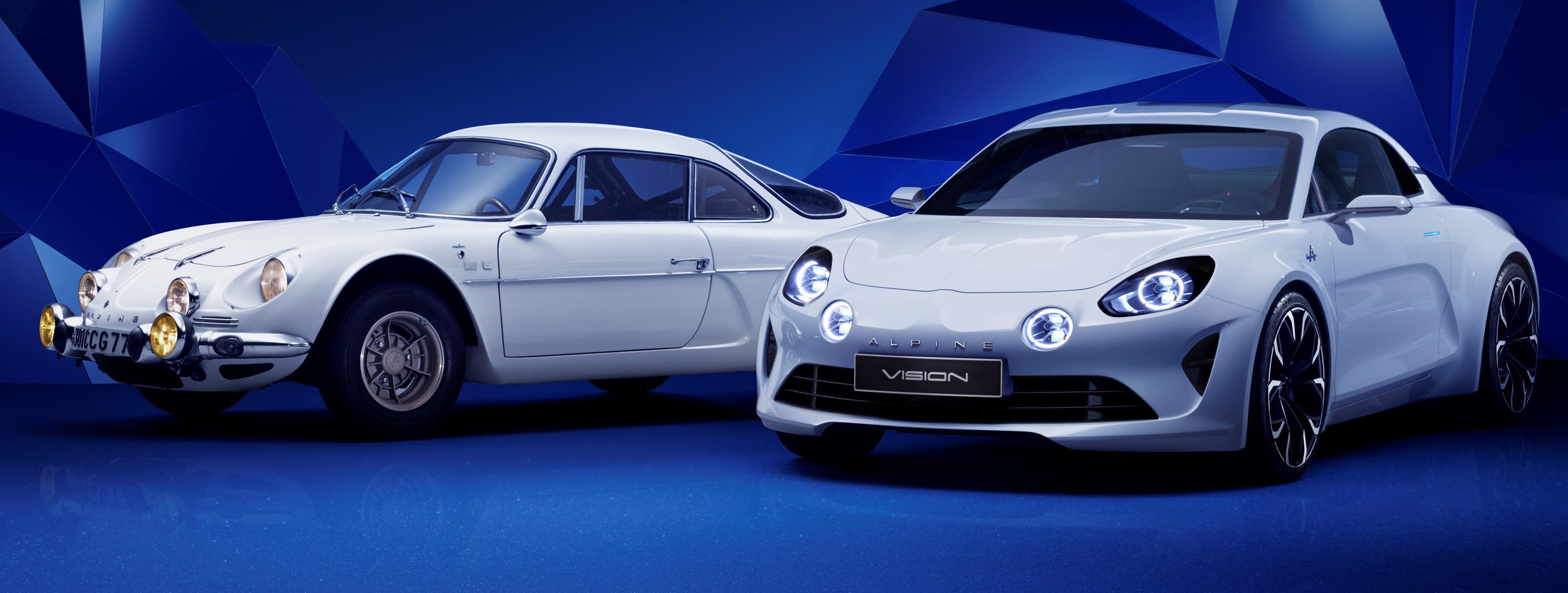
- Retromobile set to play host to six classic Alpine models
- The Alpine Vision show car will also be on display as a symbolic bridge between the brand’s past and future
Groupe Renault is pleased to confirm Alpine’s participation in the 42nd Retromobile at the Porte de Versailles exhibition centre in Paris.
Just days away from the global unveil of the brand’s eagerly-anticipated new sports car that will go on sale this year, Alpine aficionados and car connoisseurs alike will have the opportunity to either discover, or rediscover, some of the most iconic models ever to have sported the famous arrowed ‘A’ badge.
ALPINE A106
The adventure begins!
This striking ‘Coach’ – launched back in 1955 – was the very first Alpine, exhibiting the unmistakable hallmarks that would go on to characterise all of the Dieppe-based manufacturer’s future models.
The son of a Dieppe Renault dealer – whom he would subsequently succeed, in so doing becoming the youngest car dealer in France – Jean Rédélé threw himself into the competitive world of motorsport in 1950. His skill behind the wheel saw him tally excellent results and class triumphs in events as prestigious as the Rallye Monte-Carlo, the Mille Miglia, the Tour de France Automobile and the daunting Liège-Rome-Liège Rally.
These successes were achieved with a Renault 4CV, but Jean Rédélé had somewhat loftier ambitions: his dream was to produce a small French sports car using as many mass-produced parts as possible. Rédélé initially conceived two ‘Renault Spéciale’ models, designed by Michelotti and rebodied by Allemano. It was, however, the Chappe brothers – Saint Maur-based coachbuilders already accustomed to working with plastics – who played a key role in the birth of the Alpine A106, the elegant polyester body of which was based upon the platform of the Renault 4CV. The name of this model was an allusion to Jean Rédélé’s victory in the Critérium des Alpes, behind the wheel of a 4CV bearing the code number 106.
On June 25, 1955, the Société des Automobile Alpine was established.
On 6 October that year, the Alpine brand was officially launched and the A106 presented to the public for the first time at the Paris Motor Show. This model would mark the first chapter of the Alpine story, with 251 cars being produced between 1955 and 1959.
ALPINE A108
In launching his small sports car brand, Jean Rédélé immediately recognised that his fledgling business would only be able to survive and thrive with a wider commercial offering. Alongside the ‘Coach’, he resolved to extend the Alpine range with the introduction of a cabriolet and a coupé.
He duly tasked Giovanni Michelotti – to whom he had entrusted the conception of his ‘Rédélé Spéciale’ – with penning an elegant and sophisticated cabriolet, playing to the key strengths of the prolific Italian designer. The prototype was ready for inspection at the beginning of 1957 in the Allemano bodyshop in Turin, where it had been built. Immediately won over, Rédélé decided to manufacture it in Dieppe. Not a sports car per se, this model was powered by the same standard engine as in the Renault 4CV and based upon the platform of the same car. The following year, the A106 cabriolet evolved by incorporating mechanical parts from the Dauphine, and then again in 1959 when the famous beams and backbone chassis and a hard top ‘welded’ to the body transformed it into the ‘Coupé Sport’.
As a marker of the car’s continuous development, the upright headlights were subsequently tilted and protected by a wind-cheating Perspex cover.
ALPINE BERLINETTE
A legend is born!
The Berlinette body shape first appeared on the Alpine A108, going on to achieve its greatest acclaim with the A110, whose elegant lines and impressive performance made it an instant automotive classic.
The A108 model debuted in 1958, with a variety of different versions swiftly following. At the 1960 Paris Motor Show, the sophisticated ‘Tour de France’ Berlinette – more graceful than its predecessors – was one of the star turns. The A108 was replaced in 1962 by the Alpine A110, powered by the same engine as the Renault 8. The Berlinette enjoyed a long commercial career: manufactured up until 1977 (1978 in the case of the FASA variant in Spain), almost 8,000 cars rolled off the production line in Dieppe, with a further 4,000 built under licence in Brazil, Mexico, Spain and Bulgaria.
Different versions of the Berlinette were equipped with different Renault powerplants (the Renault Dauphine, Renault 8, Renault 8 Major and Gordini, Renault 12 TS and Gordini… not forgetting, of course, the Renault 16!) generating outputs of between 50hp and 138hp.
In evidence of its sporty genes, the A110 Berlinette would establish itself as one of the very best rally cars of its generation, achieving success and fame in equal measure in the hands of some of the discipline’s greatest drivers: between 1967 and 1976, the A110 dominated national series, lifted the European laurels and – in 1973 – clinched the inaugural World Rally Championship manufacturers’ crown. Along the way, the car won some of the most prestigious events on the world championship calendar, from the Rallye Monte-Carlo to the Tour de Corse, the Acropolis Rally, the Rallye du Maroc and the Sanremo Rally.
ALPINE A310
After the legendary Berlinette, Alpine founder Jean Rédélé launched the Alpine A310 to meet the expectations of the very keenest of drivers, who were clamouring for a car that married speed, comfort, reliability, exclusivity and a sporty nature.
The A310 retained the principal traits of the A110: mid-rear engine, backbone chassis and a very distinct 2+2 seat layout. Its 1.6-litre four-cylinder engine subsequently made way for a PRV V6 unit, which – combined with modifications to the car’s chassis and suspension and a subtle but effective redesign – instilled in the A310 the spirit that it had arguably been lacking.
With Alpine now owned by Renault, the A310 was a regular on the rallying scene and won the French Rally Championship in 1977. The decision was taken to produce a road-going A310 fitted as standard with a special body kit. The result was the Alpine A310 ‘Pack GT’, which boasted two triple Weber carburettors that enabled it to sprint to a top speed of 146mph, before the ‘GTA’ took over in 1985 with a choice of either a naturally-aspirated V6 GT or a V6 Turbo powerplant.
ALPINE GTA
The Alpine GTA was the first Alpine to be designed entirely under Renault’s leadership, with the support of the factory in Dieppe.
The objective was to develop a car whose turbocharged engine made it sporty, whose excellent drag coefficient made it economical to run and whose handling and interior layout were the last word in modernity. Not only that, but it benefitted from a number of innovations including flush door windows.
The product managers were confident that this vehicle’s ‘Renault Alpine’ moniker and widespread distribution across the Renault network would be the keys to its success, and it proved notably popular in both Germany and Switzerland, two countries renowned for their exacting demands when it comes to sports cars. A total of 4,660 V6 Turbo versions were produced between 1985 and 1990, and 1,509 naturally-aspirated V6 GT variants.
ALPINE A610
The A610’s capabilities were entirely in-keeping with what was expected of a large European GT car, with first-class levels of comfort and performance.
Right from its launch, the Alpine A610 set out its stall as one of the world’s finest sports cars, with improved roadholding and balance at high speeds, enhanced comfort and refinement worthy of a premium executive saloon. Moreover, its generous standard equipment was indicative of this change in philosophy: ABS, air conditioning, power steering and steering wheel-mounted radio controls… No previous Alpine had ever come so well-equipped.
As an official partner to the 1992 Albertville Winter Olympics, Renault produced a limited-edition run of high-end versions of models from its range. Alpine was represented by the A610, complete with special Gardenia White paintwork, white wheel rims with machined gloss edges, side stripes and a badge bearing the official logo of the Winter Olympic Games, as well as light grey leather upholstery with electric blue piping.
In the midst of all its illustrious predecessors on display at Retromobile, the Alpine Vision show car embodies a high-performance, elegant and lightweight sports car dedicated to the very purest form of driving pleasure.
This show car offers a tantalising preview of the road-going model that Alpine will officially unveil at the Geneva International Motor Show on 7 March. Launched in Monaco last February, the Vision hints at the shape of the forthcoming Alpine while at the same time providing the first clues about the car’s mechanical make-up. As in all Alpines, its engine is located behind the seats, in a mid-rear position.
Both the Vision and the model that it prefigures have been designed in-line with the following objectives that place the emphasis firmly on driving enjoyment:
- The driver feels perfectly at one with the vehicle, completely in control and experiences every twist and turn of the road
- The agility of a lightweight, elegant design that focuses firmly on the essentials
- The authenticity of a sports car that follows in a long line of iconic Alpine models
Manufactured in Alpine’s Dieppe factory in France, the brand’s new sports car will go on sale in 2017, initially in Europe and subsequently throughout the world.


